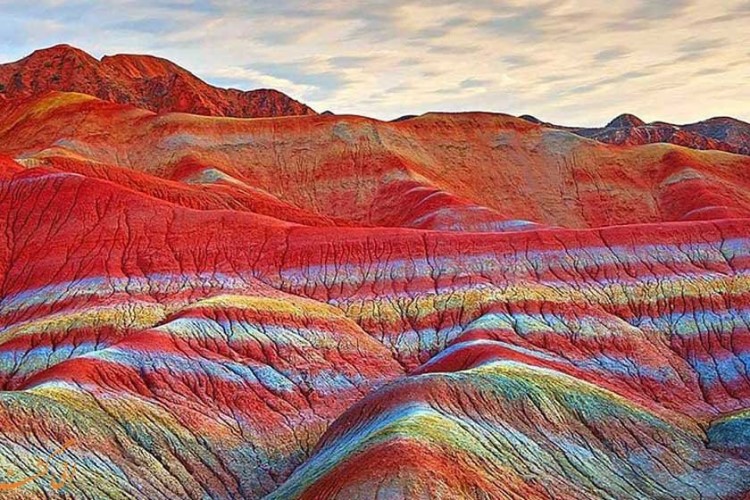
As one of the largest countries in the Middle East and the Asian continent, Iran has all kinds of places for tourists to visit. Whether you are looking for natural attractions or places made by humans, there will definitely be an option for you in Iran. In this article of the Navaran website, we will introduce you to 7 of the most mysterious places you can visit by car.
In this list, we will introduce you to many different stuff, from scary places in Iran to strange places in Iran and many other attractive places. So, if you love traveling by car and want to see the mysterious places in Iran up close, stay tuned.
Rig-e Jenn (Dune of the Jinn)
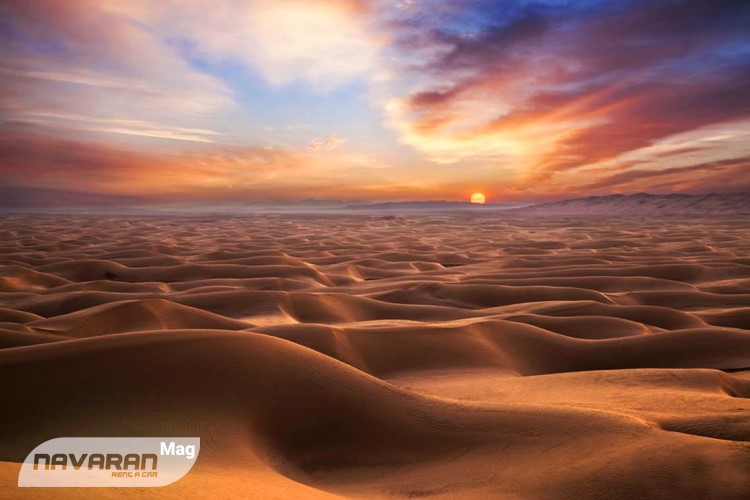
Desert trekking is among the adventures that require a brave and powerful person, particularly when your destination is a harsh desert. Rig-e Jenn desert is considered one of the mysterious places in Iran and the Garmsar areas, which were inaccessible and unknown for many years because of its special geographical conditions. These days, traveling to this region has become more affluent and welcomes all those who are interested.
If you are also one of those who like to discover the unknown and travel to mysterious places in Iran, you cannot miss the Rig-e Jenn desert. An excursion to the Rig-e Jenn desert will be a special and unique experience for every nature traveler, given the dangers and special characteristics of the desert.
Rig-e Jenn desert is probably one of the most difficult regions in the world, situated in the southwest and west of the Kavir plain. It is a destination for many tourists every year. It is located in the border region of Semnan and Isfahan provinces. Covering 3,800 square kilometers, this desert area is the third largest in Iran and is largely placed in Semnan province.
Being one of the most mysterious and scary places in Iran, Rig-e Jenn is not even mentioned in most of the ancient maps. There are many sandy swamps in this area, where any living creature can easily perish. Sadly, there have been no swamps formed in the region because of drought periods and lack of rain in recent years.
Up to a few years ago, there was no rationale for what was happening in the Rig-e Jenn Desert, with its salt fields being the burial place of many living creatures and travelers. Nobody would dare to travel to this area, and the mystery of this desert remained undiscovered. Drowning and sinking in mud and mire are among the deadliest events that can happen to any unskilled traveler in the Rig-e Jenn area.
To reach here, we suggest the Jandaq route to Rig-e Jenn, a route that is also used by many desert trekkers. Following this route, you must first get to Jandaq, which is 170 kilometers away from Tehran; you then move from the west side of Jandaq toward Rig-e Jenn. Heading to Jandaq, you will cross the city on a twisting road and arrive at a wide river. Mountains and sand dunes rise on the other side of the river. A portion of this area is almost flat or has small hills, which are fairly easy to cross. As you cross this area, swampy areas appear almost south of Rig-e Jenn.
Kal Jeni Valley
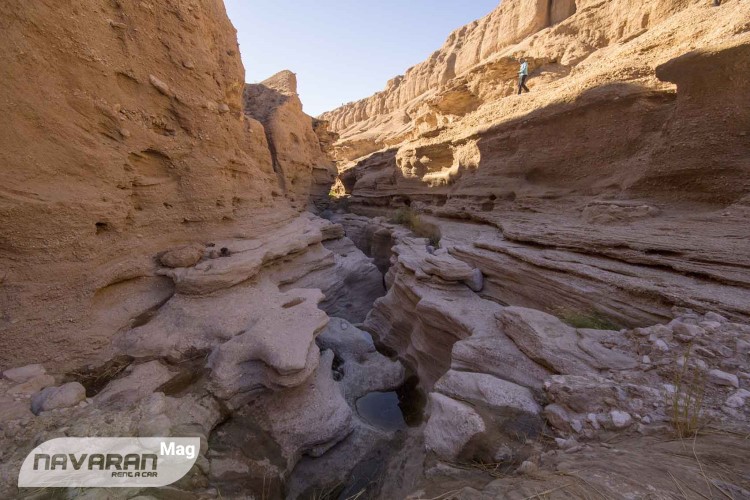
Kal Jeni, or Kal Jennian is a mysterious area located in the city of Tabas in South Khorasan province. It is a beautiful, scary valley full of wonders, and one of the famous mysterious places in Iran, where jinns and ghosts live, according to the locals. You can observe the unique nature and ancient civilization in this mysterious and attractive place and enjoy a different experience in the heart of the desert.
The name of Kal Jeni Valley is composed of two parts "Kal" and "Jeni". Kal means valley or path created by floods and water streams. Local people say that in the past, this valley was very scary and a place where ghosts and jinns lived; this is why the second part was added to the name of this valley.
The valley's shape and structure are so that the wind blowing through the cracks of the valley (especially at night, when it becomes more intense) creates strange sounds. Historically, people in this area would actually hear the sound of the wind blowing between the stones, both strange and scary sounds that convinced them of the presence of djinns in this valley.
Kal Jeni is about eight kilometers long and stuns every visitor with its high and steep walls. For the first three kilometers of the Kal Jeni River, there are limestone cliffs, while the middle two kilometers are different. The last three kilometers feature a dry river in a bed of alluvial sediments. One of the best things about Kal Jeni is the cool breeze in this valley, a breeze which helped to create a unique paradise in this desert area.
When traveling by car, the shortest and the best route is from Tehran to Semnan and then to Tabas. You can reach the valley of Kal Jeni Tabas in several ways. For example, starting from Tabas, drive north on the Dastgerdan road to Eshgh Abad city. You will reach a waterway after about 20 kilometers, where the Ezmeyghan River has left its sediments in the plain after its exit from the Kal Jeni. Continue following the waterway north for another five kilometers to reach the deep and narrow parts of the Kal Jeni valley after some turns.
Darrey-e Setaregan (The Valley of Stars)
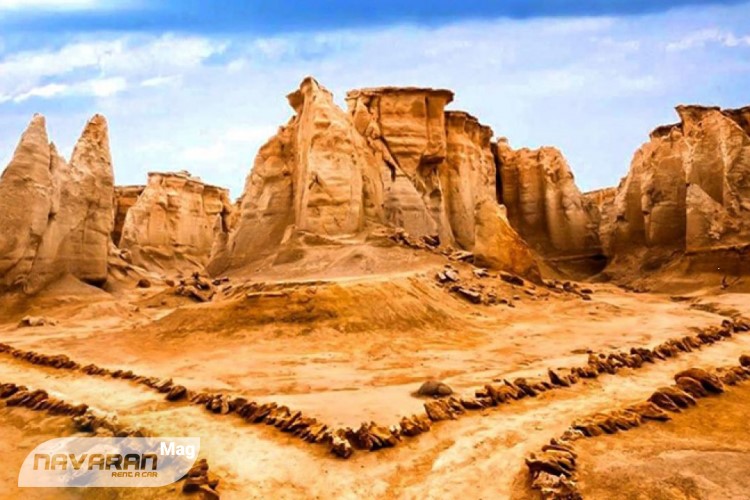
The Darrey-e Setaregan is considered one of the unique geological phenomena included in the list of the seven wonders of Qeshm, with an age of more than two million years, dazzling the eyes of any observer. There are only a few examples of this valley in the world, which is one of the most mysterious places in Iran and has exciting attractions that include pointed cones, huge pillars and high walls.
These natural phenomena are formed by erosion caused by seasonal rains, surface water and strong winds. At the same time, inside each column of this valley there are many layers and holes into which the air easily penetrates. Darrey-e Setaregan is among the most popular geotopes in Qeshm Geopark and is called "Star Oftideh" by locals, meaning "Fallen Star". This is because the locals of this region believe that the crash of a star (meteorite) on the Earth resulted in stones and soil being thrown into the air, thus forming this valley; that is why they called it the "Fallen Star".
The legends of Qeshm locals have it that the Darrey-e Setaregan is where jinns and ghosts live at night. Many people think that the strange noises coming from this valley at night are because of the presence of these creatures. So they advise tourists not to step into the Darrey-e Setaregan at night. According to geological researchers, the cause of these sounds is the wind blowing in the openings and holes in the rocks, producing a special sound when passing through these passages and crevices.
You will drive a long route from Tehran to Bandar Abbas, where you should take a ferry to make it to Qeshm Island. Darrey-e Setaregan is one of the sights of Hormozgan, located on the northern side of Qeshm Island and near the village of Berkeh Khalaf. Driving from the city of Qeshm to the south coast of the island, you can reach the mentioned village, which is five kilometers away from the south coast of the island, and you will be able to observe the most beautiful erosion phenomena on the island in the north of this village.
Babak Castle
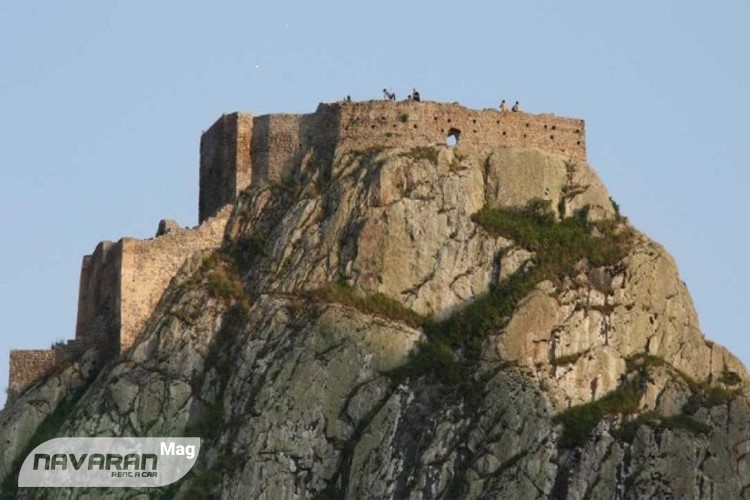
Babak Castle is located in the city of Kaleybar in the province of East Azarbaijan and is considered one of the most famous historical castles in the country and mysterious places in Iran, an ideal place for history lovers. Lying in the beautiful area of Arasbaran, for 20 years, this castle was the residence and fighting place of Babak Khorramdin, who was one of the most famous Iranian generals.
Owing to this ancient fortress, for twenty years, he and his friends were able to make the Arab soldiers stray into the woods and put them to flight. The only way to enter the castle is through the main gate. Once you leave the gate and the rampart, you will have to go through a narrow passage leading 100 meters steeply uphill. You will then reach the entrance of the castle.
There are four semi-cylindrical observation posts on the four sides of the castle and inside the natural supports of the mountain walls, where the soldiers could watch the surrounding area for kilometers. Entering the main castle requires passing through another entrance consisting of an irregular staircase flanked by two false columns.
The route between Tehran to Tabriz is around 600 kilometers, and you will pass cities like Qazvin and Zanjan. From Tabriz, to get to Kaleybar, you must go to Ahar and then drive another 60 kilometers north to reach Kaleybar. Proceed your way with the help of various signs which point to Babak Hotel or Babak Castle; you could also ask for the help of the locals.
Takht-e-Soleyman
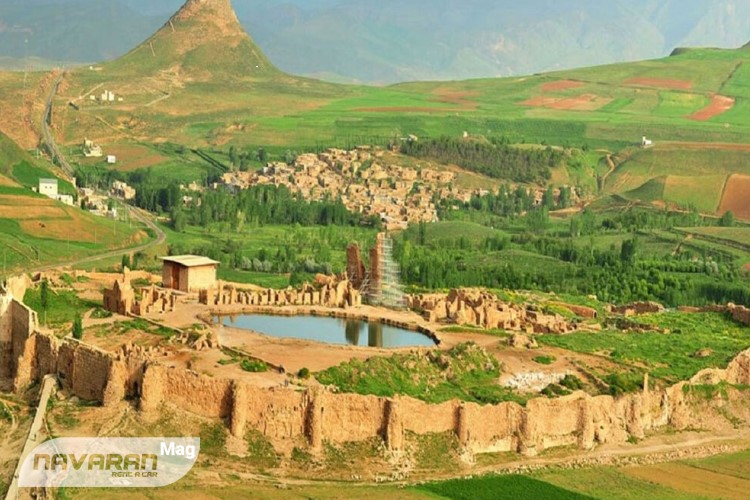
Dating back 3000 years, this unique and outstanding complex, whose name is included in the UNESCO World Heritage List, represents one of the best mysterious places in Iran and is located in the city of Takab. Takht-e-Soleyman was the largest educational, religious and prayer center pre-Islam and is renowned as the most important base of Zoroastrianism. Takht-e-Soleyman World Heritage Site has different parts, such as Azargoshnasp Fire Temple, Ivan Khosrow, Anahita Temple, small fire pits, and so on.
The ancient city of Takht-e-Soleyman used to be the residence of Medes, Achaemenids, Parthians, Sassanids and Mongols, being at the peak of prosperity and power in all these eras. Takht-e-Soleyman dates back three thousand years, and its eternal fire during seven centuries was considered a sign of the greatness and the authority of the Sassanid rule and the Zoroastrian religion. This area was, in fact, the largest center for religious education and training of Zoroastrian priests in the Sassanid period.
Several traditions exist about the bubbling of the spring of Takht-e-Soleyman Lake. One tradition says that Prophet Suleiman hit his stick on the ground, and right there where the stick hit the ground, a spring rose and turned into a lake over time. Many legends exist concerning the existence of treasures in the depths of the lake, yet, there is no mention of the discovery of these treasures in any historical period.
The lake's great depth and the floating matter in the water have kept explorers from finding out the legend's truth. German divers entered the lake for the first time but could not make any findings due to sediments and water pressure.
Takht-e-Soleyman is situated 45 km northeast of Takab city in the southeast of West Azarbaijan province. To go from Tehran to Takht-e-Soleyman, you have to go to Qazvin and then to Zanjan and from there to Bijar, Takab and Takht-e-Soleyman. The Tehran, Islamshahr, Saveh, Kabudar Ange, Bijar and Takab route also takes you to Takht-e-Soleyman. Other routes like Miandoab, Shahin Dezh, and Takab, as well as the road of Zanjan, Dandi, and Takht-e-Soleyman, are other options at your disposal.
Ghar-e Parau (Killer Cave)
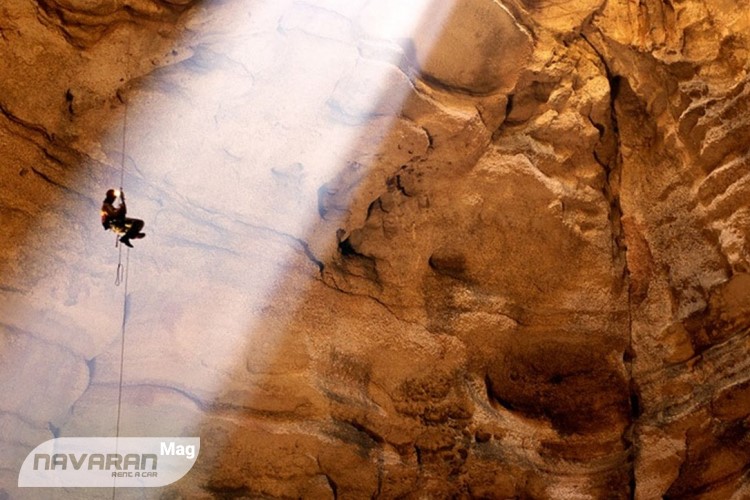
Ghar-e Parau is the deepest cave in Iran, located at an altitude of 3,050 meters on Mount Parau in the heart of the Zagros Mountains. Known as the killer cave, this is one of the attractions worth seeing in Kermanshah. The cave is famous as one of the roughest vertical caves in the world. Nicknamed "Everest of the world's caves" at its discovery, Ghar-e Parau is now included in the list of Iran's national natural monuments. Ghar-e Parau is considered one of the most mysterious places in Iran.
This unique Ghar-e Parau was discovered in 1971. During mapping and research work in the Zagros highlands that year, one group of British engineers and geologists spotted a cave entrance; from their experience with the geological nature of the area, they believed that there was a deep and large cave there. To this day, five Iranian speleologists have died while traveling in Ghar-e Parau; hence, this cave is also known as the "Killer Cave". Sadly, some of the corpses from Ghar-e Parau were never retrieved.
The almost 500 kilometers route between Tehran and Kermanshah only takes around 6 hours of driving. To arrive at Ghar-e Parau from the city of Kermanshah, you must go through Beheshti Street in the city center to Keshvari Boulevard and turn north from the right exit after a few kilometers to Namaz Boulevard and follow the route to the northeast until you reach the foot of the mountain.
Darvish Khan Stone Garden
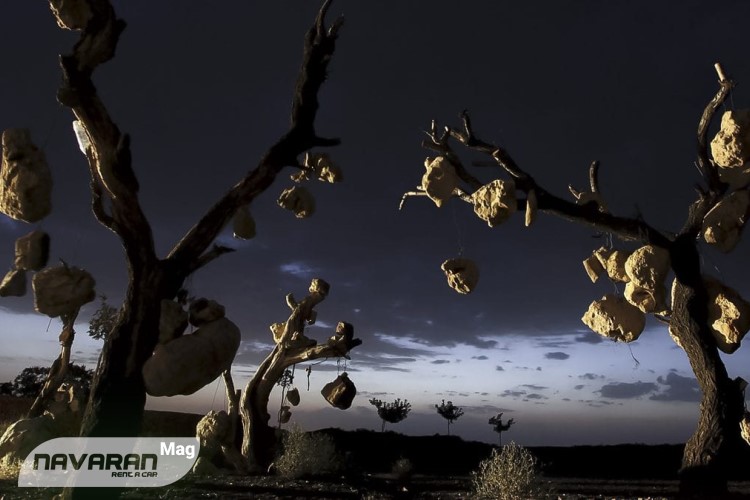
There is a garden on dry land in a corner of the city of Sirjan, built by Darvish Khan Esfandiarpour. There is no trace of life in this garden, and everything has been dead for years. What lies before us is a garden shaped like an irregular hexagon, with only dry trees instead of greenery and with fruits made of stone. A mystery is hidden in the seeds of these stone fruits.
This garden is full of unanswered questions which will never be answered, and the more you pass through it, the more your mind gets caught up in its mysteries. The Darvish Khan Stone Garde, being one of the mysterious places in Iran, was constructed by a deaf man named Darvish Khan Esfandiarpour, who was a farmer.
The Darvish Khan Stone Garden is situated in the village of Balvard in the village of Miandoab, some 40 km southeast of Sirjan. You must go to Kerman to reach this garden and then take the Sirjan-Baft road. After 30 km and driving through Balvard, Hyderabad and Miandoab, you will see the signpost for Bagh Sangi tourist area. At this point, you should turn into the side road and continue for four kilometers on the dirt road. You will then see the rock garden.
7 Best mysterious places in Iran: Conclusion
We introduced some of the best mysterious places in Iran, which you can visit by car. Some of these unexplored places in Iran will be a great choice if you love road trips and are into exploring such interesting places in Iran. As a tourist, you can easily rent a car in Iran and embark on your mysterious journey to any of these places.
If you are looking for automobile rental in Iran services for your next trip in search of epic places in Iran, you can check out Navaran. With a fleet of perfectly maintained cars, you can expect top car rental in Iran services with competitive prices and straightforward conditions to rent an automobile in Iran. So which one of these mysterious places in Iran has got your attention? Let us know in the comments below.
